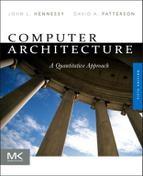G
Gather-Scatter
definition, 309
GPU comparisons, 329
multimedia instruction compiler support, A-31
vector architectures, 279–280
GDDR See Graphics double data rate (GDDR)
General-purpose registers (GPRs)
advantages/disadvantages, A-6
ISA classification, A-3 to A-5
MIPS data transfers, A-34
MIPS operations, A-36
MIPS64, A-34
VMIPS, 265
Geometric means, example calculations, 43–44
GFS See Google File System (GFS)
Global address space, segmented virtual memory, B-52
Global common subexpression elimination, compiler structure, A-26
Global data area, and compiler technology, A-27
Global load/store, definition, 309
Global scheduling, ILP, VLIW processor, 194
GPRs See General-purpose registers (GPRs)
GPU (Graphics Processing Unit)
banked and graphics memory, 322–323
definition, 9
DLP
basic considerations, 288
basic PTX thread instructions, 299
conditional branching, 300–303
coprocessor relationship, 330–331
definitions, 309
Fermi GPU architecture innovations, 305–308
Fermi GTX 480 floorplan, 295
mapping examples, 293
Multimedia SIMD comparison, 312
multithreaded SIMD Processor block diagram, 294
NVIDIA computational structures, 291–297
NVIDIA/CUDA and AMD terminology, 313–315
NVIDIA GPU ISA, 298–300
programming, 288–291
SIMD thread scheduling, 297
terminology, 292
fine-grained multithreading, 224
future features, 332
gather/scatter operations, 280
loop-level parallelism, 150
vs. MIMD with Multimedia SIMD, 324–330
power/DLP issues, 322
raw/relative performance, 328
Roofline model, 326
strided access-TLB interactions, 323
thread count and memory performance, 332
TLP, 346
vector kernel implementation, 334–336
GPU Memory
caches, 306
CUDA program, 289
future architectures, 333
GPU programming, 288
splitting from main memory, 330
Graph coloring, register allocation, A-26 to A-27
Graphics-intensive benchmarks, desktop performance, 38
Graphics Processing Unit See GPU (Graphics Processing Unit)
Graphics synchronous dynamic random-access memory (GSDRAM), characteristics, 102
Greatest common divisor (GCD) test, loop-level parallelism dependences, 319, H-7
Grid
arithmetic intensity, 286
CUDA parallelism, 290
and GPU, 291
GPU Memory structures, 304
GPU terms, 308
mapping example, 293
NVIDIA GPU computational structures, 291
SIMD Processors, 295
Thread Blocks, 295
Guest definition, 108
Guest domains, Xen VM, 111
..................Content has been hidden....................
You can't read the all page of ebook, please click here login for view all page.
